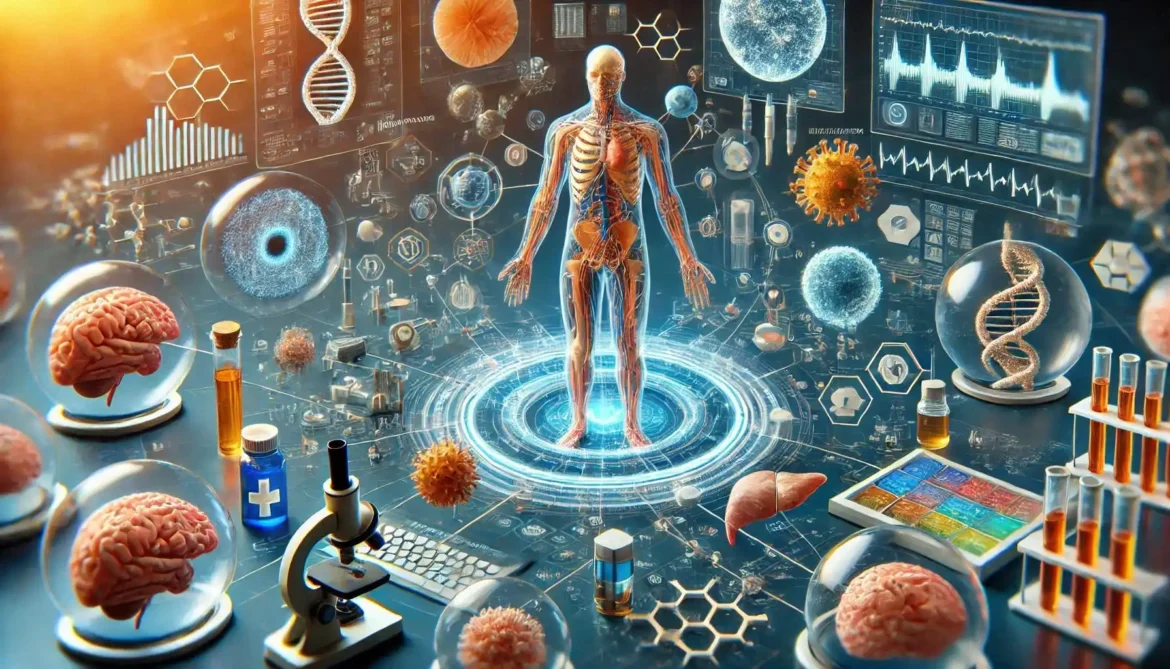
The human body consists of eleven major organ systems, each with specific functions that contribute to overall health and homeostasis. Below is a detailed list of these systems, their functions, and their importance.
- Cardiovascular System Main Organs Heart, blood vessels (arteries, veins, capillaries)Functions Circulates blood, delivering oxygen and nutrients to cells while removing waste products.
Importance Essential for transporting substances throughout the body and maintaining temperature.
- Digestive System
Main Organs Mouth, esophagus, stomach, intestines, liver, pancreas, rectum
Functions Breaks down food into nutrients for absorption and eliminates waste.
Importance Vital for nutrient intake and energy production necessary for bodily functions. - Endocrine System
Main Organs Glands (pituitary, thyroid, adrenal), pancreas, ovaries, testes
Functions Produces hormones that regulate metabolism, growth, reproduction, and other bodily functions.
Importance Critical for maintaining homeostasis through hormonal balance. - Integumentary System
Main Organs Skin, hair, nails
Functions Protects the body from external damage, regulates temperature, and provides sensory information.
Importance First line of defense against pathogens and environmental hazards. - Lymphatic System
Main Organs Lymph nodes, lymphatic vessels, spleen
Functions Maintains fluid balance and plays a key role in immune response by filtering pathogens from lymphatic fluid.
Importance Important for immune defense and fluid regulation in the body. - Muscular System
Main Organs- Skeletal muscles, cardiac muscle, smooth muscle
Functions Facilitates movement of the body and its parts; maintains posture; generates heat through muscle activity.
Importance Enables voluntary movements and vital functions like heartbeats and digestion. - Nervous System
Main Organs Brain, spinal cord, peripheral nerves
Functions Processes sensory information and coordinates responses; controls voluntary and involuntary actions.
Importance Central to communication within the body and response to stimuli. - Reproductive System
Main Organs Male: testes, penis; Female: ovaries, uterus
Functions Produces gametes (sperm and eggs) and hormones; facilitates reproduction and development of offspring.
Importance Essential for species continuation through reproduction. - Respiratory System
Main Organs Nose, pharynx, larynx, trachea, bronchi, lungs
Functions Facilitates gas exchange (oxygen intake and carbon dioxide removal) during breathing; assists in vocalization and olfaction (smell).
Importance Crucial for providing oxygen for cellular respiration and removing waste gases. - Skeletal System
Main Organs Bones, cartilage, ligaments
Functions Provides structural support; protects internal organs; facilitates movement by serving as attachment points for muscles; stores minerals like calcium.
Importance Fundamental for maintaining body shape and protecting vital organs. - Urinary System
Main Organs Kidneys, ureters, urinary bladder, urethra
Functions Filters blood to remove waste products; regulates water balance and electrolytes; produces urine for excretion.
Importance Key for waste elimination and maintaining fluid homeostasis in the body.
How do the different systems of the body interact with each other;
The various systems of the human body interact intricately to maintain homeostasis and ensure proper functioning. Here’s how different systems collaborate:
Interaction Among Body Systems
- Nervous System
Role: The nervous system acts as the control center, sending signals to regulate the activities of other systems.
Interactions:
Muscular System: It directs muscle contractions for movement and reflex actions.
Endocrine System: Coordinates with hormonal signals to manage long-term bodily functions like growth and metabolism. - Cardiovascular System
Role: Transports oxygen, nutrients, hormones, and waste products throughout the body.
Interactions:
Respiratory System: Works closely to deliver oxygen to blood in the lungs and remove carbon dioxide from it.
Digestive System: Absorbs nutrients from digested food into the bloodstream for distribution. - Digestive System
Role: Breaks down food into nutrients and eliminates waste.
Interactions:
Cardiovascular System: Nutrients absorbed from digestion are transported via blood to various cells in the body.
Nervous System: Regulates digestive processes through autonomic control, ensuring efficient breakdown and absorption of food4. - Respiratory System
Role: Facilitates gas exchange—bringing in oxygen and expelling carbon dioxide.
Interactions:
Cardiovascular System: Oxygen is picked up by blood in the lungs and delivered to tissues; carbon dioxide is transported back to the lungs for exhalation
Nervous System: Controls breathing rate based on carbon dioxide levels in the blood. - Endocrine System
Role: Releases hormones that regulate various bodily functions.
Interactions:
Nervous System: Works with the nervous system to coordinate immediate responses (like fight-or-flight) and longer-term processes (like growth) through hormonal signals25.
Reproductive System: Hormones regulate reproductive functions and development5.
Muscular System
Role: Enables movement and generates heat.
Interactions:
Skeletal System: Muscles attach to bones, allowing movement when muscles contract1.
Cardiovascular System: Muscles require oxygen delivered by blood for energy production during activity. - Skeletal System
Role: Provides structure, protection, and facilitates movement.
Interactions:
Muscular System: Bones serve as levers for muscle action
Cardiovascular System: Produces red blood cells in bone marrow, essential for oxygen transport. - Lymphatic and Immune Systems
Role: Protects against infections and maintains fluid balance.
Interactions:
Works with the cardiovascular system to filter pathogens from blood and transport immune cells throughout the body.
The systems of the body do not function in isolation; they are interdependent. For example, without proper respiratory function, the cardiovascular system cannot effectively deliver oxygen, which is vital for cellular metabolism across all systems. This interconnectedness emphasizes that a failure in one system can lead to dysfunctions in others, highlighting the importance of cooperation among all organ systems for overall health and survival.
FAQs
Q1: How can I keep my cardiovascular system healthy?
A1: To maintain a healthy heart and blood vessels, engage in at least 150 minutes of moderate aerobic exercise per week, such as walking or cycling. Eat a diet rich in fruits, vegetables, whole grains, and lean proteins while limiting saturated fats, salt, and processed foods; also, maintain a healthy weight and avoid smoking. Regular check-ups for blood pressure, cholesterol, and blood sugar levels can help detect issues early.
Q2: What are some ways to keep the respiratory system healthy?
A2: Protect your lungs by avoiding smoking and secondhand smoke, and minimize exposure to air pollutants like dust or chemicals. Practice deep breathing exercises, stay physically active to strengthen lung capacity, and get vaccinated against respiratory infections like the flu and COVID-19. Maintaining good indoor air quality, such as using air purifiers in polluted areas, can also support respiratory health.
Q3: How can I support my digestive system?
A3: Promote digestive health by eating a fiber-rich diet with plenty of fruits, vegetables, whole grains, and probiotics (found in yogurt or fermented foods) to aid gut bacteria. Stay hydrated, chew food thoroughly, and eat regular, balanced meals while limiting processed foods, alcohol, and excessive caffeine. If you experience persistent issues like bloating or constipation, consult a doctor for potential underlying conditions.
Q4: What tips can help keep the nervous system healthy?
A4: Support your brain and nerves by getting 7-9 hours of quality sleep per night, managing stress through techniques like meditation or yoga, and engaging in mental activities such as reading or puzzles. Eat a nutrient-dense diet with omega-3 fatty acids (from fish or nuts), vitamins (like B12 from eggs and meat), and antioxidants (from berries), and limit alcohol and substance use to prevent damage.
Q5: How do I keep my immune system strong?
A5: Boost your immune system by maintaining a balanced diet full of vitamins C and D (from citrus fruits, leafy greens, and sunlight), getting regular exercise, and ensuring 7-9 hours of sleep nightly. Practice good hygiene, such as washing hands frequently and getting vaccinated, and manage stress to reduce inflammation. Avoid excessive sugar and processed foods, as they can weaken immune responses.
Q6: What are some ways to maintain the muscular and skeletal systems?
A6: Strengthen muscles and bones through weight-bearing exercises like weightlifting or walking for at least 30 minutes most days, and incorporate stretching to improve flexibility. Consume a diet rich in calcium (from dairy or fortified plant milks), vitamin D (from sunlight or supplements), and protein (from lean meats or beans) to support bone density and muscle repair. Avoid prolonged sitting and maintain good posture to prevent strain.
By incorporating these habits into your daily routine, you can promote the health of your body’s interconnected systems. If you have specific health concerns, always seek advice from a qualified healthcare provider for tailored recommendations. Staying proactive with regular check-ups and a healthy lifestyle is key to long-term well-being!
Medical Disclaimer:
The information provided on this website is for general educational and informational purposes only and is not intended as a substitute for professional medical advice, diagnosis, or treatment. Always seek the advice of your physician or other qualified health provider with any questions you may have regarding a medical condition. Never disregard professional medical advice or delay in seeking it because of something you have read on this website.



